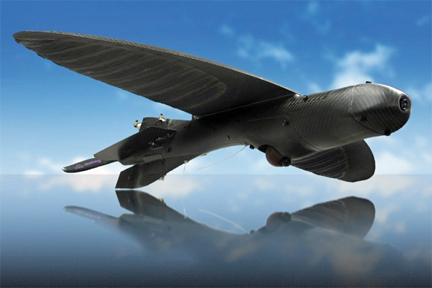
[SatNews] The U.S. Army recently purchased 36 Maveric unmanned aerial systems as a result of an urgent request from soldiers in combat.
The request was made to the Rapid Equipping Force, or REF, at Fort Belvoir, Virginia, in March, and Soldiers will receive them by December. The 36 Maverics, which are not in the Army's current unmanned aerial system, or UAS, inventory, cost $4.5 million and are made by Prioria Robotics Inc., a technology firm in Gainesville, Florida. The Maveric is classified in the micro-UAS category as it is smaller than the Army's Raven and Puma systems, according to Tami Johnson, project manager, REF. Maveric will support Soldiers at the squad level, she added, while Raven and Puma are company-level tactical assets. Another difference, she pointed out, is Maveric's wings are flexible and enable the system to naturally blend into the environment.

The Army recently purchased 36 Maveric unmanned aerial system vehicles, the same as depicted here, for a special mission.
Photo Credit: courtesy of Prioria Robotics Inc.
"Puma and Raven are both dependable systems," she said. "However, this requirement called for a small, subtle capability that could be employed by a single Soldier. Maveric meets this unique requirement."
Johnson said Maveric can be flown for 60 minutes before it needs to be refueled. It also contains sensors for day, night or obscured hazy environmental reconnaissance work. The Maveric cruises at 26 knots and dashes up to 55 knots, but more importantly can fly in sustained winds of 20 knots and up to 30-knot gusts.
At this time, the REF has no plans to purchase more Maverics, but that could change pending Soldier feedback or additional requirements from theater, Johnson said. She added the REF will continue to work closely with the program manager for Army UAS, informing them of any Soldier assessments or requirements as they come in.
"We anticipate that the systems will be equipped in late 2013 and we are eagerly awaiting Soldier feedback on performance," she said.
Maveric did undergo testing earlier this year at Yuma Test Center in Arizona by the Army Testing and Evaluation Command, which published a Safety Release for Soldier Training, Safety Confirmation and Capabilities and Limitation report.
Johnson explained the role REF plays in acquiring new technologies, "As the REF procures emerging capabilities to meet urgent Soldier requirements, we are often inserting technologies for the first time and assessing operational performance," Johnson explained. "Maveric UAS is a good news story for the REF. It demonstrates our ability to validate a unique requirement, canvass emerging commercial-off-the-shelf and government-off-the-shelf technologies, and partner with other Army organizations to quickly place capabilities into the hands of Soldiers."
For further details on the company and the Maveric, head over to http://www.prioria.com/
As if building one satellite that’s likely to reach orbit weren’t enough, Concordia University students are working on a second.
ConSat-1 is in the final stages of assembly, and if it passes all its tests the European Space Agency has promised to launch it. It could happen next year.
ConSat-2, a different design, is also in the works, giving Concordia not just one satellite but a whole space program.
And the satellites weren’t even required course work.
“It’s amazing,” said Mehdi Sabzalian, a mechanical engineering student and project leader for ConSat-2.
“We’re coming to the end for the first satellite and the second satellite is catching up. It’s very exciting to see it.”
“You put so much of your life into it and it’s so satisfying when you reach a milestone,” said student Nick Sweet. “Every small victory is magnified because of the amount of work we put into it. I don’t remember many of us having weekends (off). Or nights.”
Concordia doesn’t have an aerospace program for undergrads, so all the students are from other areas of engineering.
The first satellite is the news of the day. The students from Space Concordia won a nationwide contest run by the non-profit Canadian Satellite Design Challenge Management Society in 2012, in which engineering schools were invited to design and build a microsatellite.
The rules were strict. This is a standard package in the satellite business, 34 cm long and 10 cm wide and deep, with a maximum weight of four kilograms. The whole thing looks like a skinny shoebox.
And it has to perform, not just coast along in space.
ConSat-1 is designed to map changes in the South Atlantic Anomaly, an area where the Earth’s inner Van Allen radiation belt dips to just 200 kilometres above Earth’s surface. Satellites and spacecraft passing through this area are exposed to extra radiation that can crash computers and disrupt signals.
And although it’s tiny, the satellite has moving parts. It is designed to deploy an antenna after it reaches orbit. The outer shell is covered with solar panels.
Now it’s on the short list of the European Space Agency’s Fly Your Satellite program.
Six microsatellites from students in six countries are on the list, and all of them could potentially fly if they’re good enough.
“They (different satellites) are not competing against each other. They are just competing with themselves to finish everything on time and pass the tests,” Sabzalian said.
The 25 students do it all: They design, make the parts and assemble.
“It’s months away from being finished,” Sabzalian said.
Launch could come in late 2014 on an ESA rocket. Microsatellites traditionally hitchhike on a rocket that’s carrying bigger satellites to space.
And the students have set up a fundraising campaign through Kickstarter to help cover their costs for ConSat-2 at http://kck.st/1fDeIX4. They want to raise $15,000, a bargain-basement price for a working satellite.
The second satellite will be an entrant in the latest contest round at the Canadian Space Agency, and everyone has hopes that it will fly too. It has to be built by May.
ConSat-2 has a different mission: It would test whether a material designed to repair itself after damage can work in the harsh conditions of space. The material is carbon fibre and epoxy resin.
“If we win, we will get a launch,” Sabzalian said. “If we don’t, we’ll still try to raise money through various means (maybe again another Kickstarter) to buy our ticket to space.”
The other ESA satellites with ConSat-1 come from Spain, Italy, Belgium Denmark and France.
Space Concordia isn’t finished. It’s entering contests for rocketry and Mars rover design next.
As if building one satellite that’s likely to reach orbit weren’t enough, Concordia University students are working on a second.
ConSat-1 is in the final stages of assembly, and if it passes all its tests the European Space Agency has promised to launch it. It could happen next year.
ConSat-2, a different design, is also in the works, giving Concordia not just one satellite but a whole space program.
And the satellites weren’t even required course work.
“It’s amazing,” said Mehdi Sabzalian, a mechanical engineering student and project leader for ConSat-2.
“We’re coming to the end for the first satellite and the second satellite is catching up. It’s very exciting to see it.”
“You put so much of your life into it and it’s so satisfying when you reach a milestone,” said student Nick Sweet. “Every small victory is magnified because of the amount of work we put into it. I don’t remember many of us having weekends (off). Or nights.”
Concordia doesn’t have an aerospace program for undergrads, so all the students are from other areas of engineering.
The first satellite is the news of the day. The students from Space Concordia won a nationwide contest run by the non-profit Canadian Satellite Design Challenge Management Society in 2012, in which engineering schools were invited to design and build a microsatellite.
The rules were strict. This is a standard package in the satellite business, 34 cm long and 10 cm wide and deep, with a maximum weight of four kilograms. The whole thing looks like a skinny shoebox.
And it has to perform, not just coast along in space.
ConSat-1 is designed to map changes in the South Atlantic Anomaly, an area where the Earth’s inner Van Allen radiation belt dips to just 200 kilometres above Earth’s surface. Satellites and spacecraft passing through this area are exposed to extra radiation that can crash computers and disrupt signals.
And although it’s tiny, the satellite has moving parts. It is designed to deploy an antenna after it reaches orbit. The outer shell is covered with solar panels.
Now it’s on the short list of the European Space Agency’s Fly Your Satellite program.
Six microsatellites from students in six countries are on the list, and all of them could potentially fly if they’re good enough.
“They (different satellites) are not competing against each other. They are just competing with themselves to finish everything on time and pass the tests,” Sabzalian said.
The 25 students do it all: They design, make the parts and assemble.
“It’s months away from being finished,” Sabzalian said.
Launch could come in late 2014 on an ESA rocket. Microsatellites traditionally hitchhike on a rocket that’s carrying bigger satellites to space.
And the students have set up a fundraising campaign through Kickstarter to help cover their costs for ConSat-2 at http://kck.st/1fDeIX4. They want to raise $15,000, a bargain-basement price for a working satellite.
The second satellite will be an entrant in the latest contest round at the Canadian Space Agency, and everyone has hopes that it will fly too. It has to be built by May.
ConSat-2 has a different mission: It would test whether a material designed to repair itself after damage can work in the harsh conditions of space. The material is carbon fibre and epoxy resin.
“If we win, we will get a launch,” Sabzalian said. “If we don’t, we’ll still try to raise money through various means (maybe again another Kickstarter) to buy our ticket to space.”
The other ESA satellites with ConSat-1 come from Spain, Italy, Belgium Denmark and France.
Space Concordia isn’t finished. It’s entering contests for rocketry and Mars rover design next.

